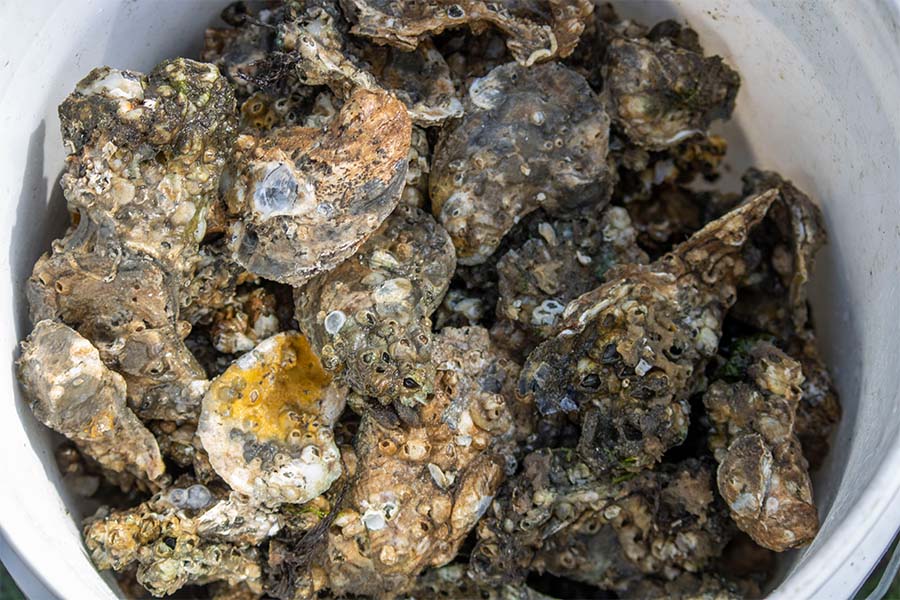Brevard Zoo‘s Restore Our Shores (ROS) team has been working on restoring the Indian River Lagoon’s health through various projects, including re-establishing oyster reefs as a natural water filter and habitat. In the past, plastic mesh bags were used to hold the shells together and line the bottom of the lagoon, but the team found that gabions – galvanized metal cages – included naturally recruited almost three times as many live oysters. The team also tried gabion corrals last year, which recruited live oysters using fewer man-made materials while cutting costs. After one year of monitoring the corrals and gabions at the Ryckman Park in Melbourne Beach, the team found that although the oyster density was slightly higher in oyster gabions, they will be moving forward with oyster corral designs for many oyster restoration projects due to the corals’ success in providing great habitat for live oyster larvae, using less man-made materials, and reducing project costs and labor needed. The team’s goal is to continue restoring the lagoon’s health while reducing plastic pollution and man-made materials.
Oyster Project Success in the Lagoon: A Remarkable Environmental Achievement
Oysters are known for their culinary delicacy, but these tiny shellfish play a crucial role in maintaining the health of marine ecosystems. Not only do oysters filter the water and help to remove excess nutrients, but they also create habitat for other organisms. Sadly, pollution, overfishing, and disease have led to the decline of oyster populations in many areas. However, one recent success story comes from the Chesapeake Bay, where the Oyster Recovery Partnership’s ‘Oyster Gardeners’ program has been instrumental in bringing the oyster population back.
What is the Oyster Project?
The Oyster Recovery Partnership is a non-profit organization dedicated to restoring oyster populations in the Chesapeake Bay. The organization’s Oyster Gardener’s program provides a way for local people, schools, and businesses to contribute to the restoration effort. Participants raise baby oysters, known as ‘spat’, in special containers attached to their docks. After nine months, the mature oysters are placed on restoration reefs, where they can continue to filter the water and provide habitat for the other creatures that depend on the Bay for their survival.
How is the Oyster Project helping to restore the Chesapeake Bay?
The Chesapeake Bay is the largest estuary in the United States and a vital ecosystem that supports many plant and animal species, as well providing economic benefits to the surrounding communities. Unfortunately, the Bay has been struggling for decades due to pollution, overfishing, and other factors. Since oysters are critical for maintaining water quality and providing habitat, restoring their population is key to rehabilitating the Bay’s ecosystem. The Oyster Recovery Partnership has been working with local businesses and individuals to plant millions of oysters on restoration reefs in the Bay. Already, the project has restored approximately 9,000 acres of oyster habitat and removed 50 tons of nitrogen from the water.
How can individuals help to support the Oyster Project?
If you live near the Chesapeake Bay, you can become an oyster gardener and contribute to the restoration effort. The Oyster Recovery Partnership will provide you with spat to raise and release on restoration reefs. You can also volunteer or donate to the organization, which depends on the support of the community to continue its work. Additionally, you can make a difference by reducing your own water usage and properly disposing of trash and other pollutants. Every little bit helps!
Final Thoughts
The Oyster Project’s success in the Chesapeake Bay demonstrates the power of collaboration and community involvement in environmental restoration. By working together, individuals, businesses, and non-profit organizations can make a significant impact on the health of our planet’s ecosystems. Restoring the oyster population in the Bay not only helps to improve water quality and support other species but also provides economic benefits for the surrounding communities. Hopefully, this success story will inspire others to take action and support the conservation of our oceans and waterways.


